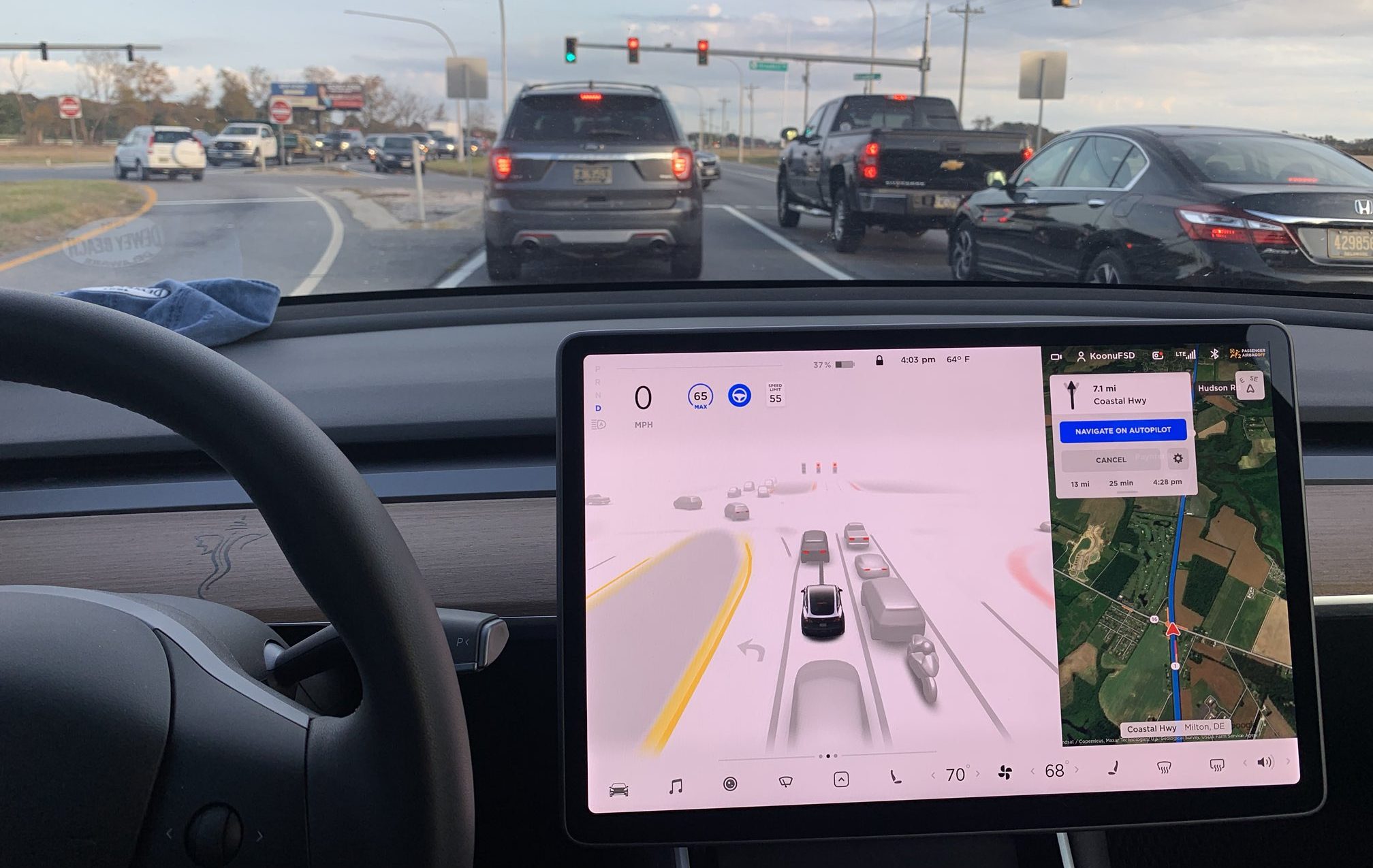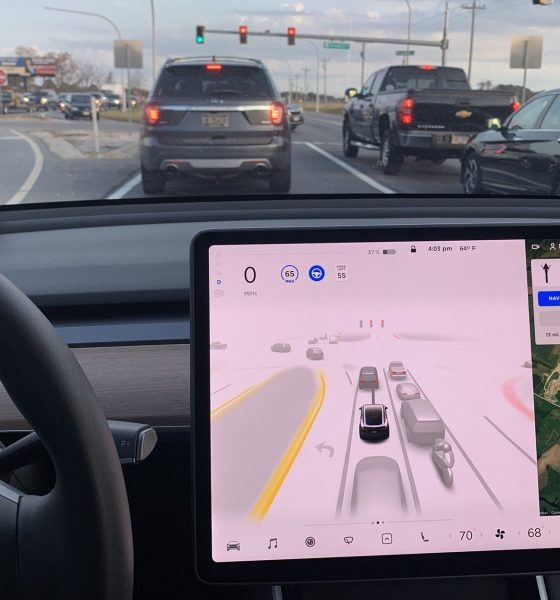Tesla may be targeting the release of FSD Beta 10.8 on Tuesday together with the company’s fun Holiday Update, but this has not stopped the EV maker from releasing FSD Beta 10.7 this past weekend nonetheless. And despite its impending quick replacement with v10.8, v10.7 seems to include a number of key updates that make the advanced driver-assist system smoother to operate.
Immediately recognizable from v10.7’s detailed Release Notes was that vehicles could now react to things quite a bit faster. With v10.7, FSD Beta would also be less likely to slow down due to bad readings from other cars and objects on the road. Also, the aggressiveness of FSD Beta seems to have been toned down to some degree, with the system now rolling and stopping smoothly for jaywalkers, instead of slamming on the brakes.
Release notes for #FSDBeta V10.7 pic.twitter.com/BFFiQh7iww
— Dirty Tesla (@DirtyTesLa) December 19, 2021
Perhaps most interestingly, however, was that FSD Beta 10.7 also effectively enables one-pedal driving by expanding the use of vehicles’ regenerative braking systems. This should make stops smoother while keeping the physical brakes as infrequently used as possible. This update would likely be a welcome change, as conversations in the r/TeslaMotors subreddit among FSD Beta testers suggest that some users are annoyed by the system’s use of physical brakes in past iterations.
The following are the specific Release Notes for Tesla’s FSD Beta 10.7.
FSD Beta v10.7 Release Notes
– Improved object attributes network to reduce false cut-in slowdowns by 50% and lane assignment error by 19%.
– Improved photon-to-control vehicle response latency by 20% on average.
– Expanded use of regenerative braking in Autopilot down to 0 mph for smoother stops and improved energy efficiency.
– Improved VRU (pedestrians, bicyclists, motorcycles, animals) lateral velocity 1 error by 4.9% by adding more auto-labeled and simulated training examples to the dataset.
– Reduced false slowdowns for crossing objects by improved velocity estimates for objects at the end of visibility.
– Reduced false slowdowns by adding geometric checks to cross-validate lane assignment of objects.
– Improved speed profile for unprotected left turns when visibility is low.
– Added more natural behavior to bias over bike lanes during right turns.
– Improved comfort when yielding to jaywalkers by better modeling of stopping region with soft and hard deadlines.
– Improved smoothness for merge control with better modeling of merge point and ghost objects positioned at the edge of visibility.
– Improved overall comfort by enforcing stricter lateral jerk bounds in trajectory optimizer.
– Improved short deadline lane changes through richer trajectory modeling.
– Improved integration between lead vehicle overtake and lane change gap selection.
– Updated trajectory line visualization.
Tesla FSD 10.8 plus holiday fun software release probably Tuesday
— Elon Musk (@elonmusk) December 18, 2021
While FSD Beta 10.7 seems quite impressive, Elon Musk has noted that v10.8 would probably be released this coming Tuesday, together with the company’s Holiday Update. Tesla’s Holiday Updates are typically comprised of fun additions to vehicles’ features such as games and tricks like the external boombox.
This time around, however, it appears that the company is ensuring that its Holiday Update brings more functionality to its ever-expanding group of FSD Beta testers. These include the capability of FSD Beta to work with other features such as Waypoints, a function that was confirmed by Musk on Twitter.
Don’t hesitate to contact us with news tips. Just send a message to tips@teslarati.com to give us a heads up.

News
Tesla (TSLA) receives “Buy” rating and $551 PT from Canaccord Genuity
He also maintained a “Buy” rating for TSLA stock over the company’s improving long-term outlook, which is driven by autonomy and robotics.

Canaccord Genuity analyst George Gianarikas raised his Tesla (NASDAQ:TSLA) price target from $482 to $551. He also maintained a “Buy” rating for TSLA stock over the company’s improving long-term outlook, which is driven by autonomy and robotics.
The analyst’s updated note
Gianarikas lowered his 4Q25 delivery estimates but pointed to several positive factors in the Tesla story. He noted that EV adoption in emerging markets is gaining pace, and progress in FSD and the Robotaxi rollout in 2026 represent major upside drivers. Further progress in the Optimus program next year could also add more momentum for the electric vehicle maker.
“Overall, yes, 4Q25 delivery expectations are being revised lower. However, the reset in the US EV market is laying the groundwork for a more durable and attractive long-term demand environment.
“At the same time, EV penetration in emerging markets is accelerating, reinforcing Tesla’s potential multi‑year growth runway beyond the US. Global progress in FSD and the anticipated rollout of a larger robotaxi fleet in 2026 are increasingly important components of the Tesla equity story and could provide sentiment tailwinds,” the analyst wrote.
Tesla’s busy 2026
The upcoming year would be a busy one for Tesla, considering the company’s plans and targets. The autonomous two-seat Cybercab has been confirmed to start production sometime in Q2 2026, as per Elon Musk during the 2025 Annual Shareholder Meeting.
Apart from this, Tesla is also expected to unveil the next-generation Roadster on April 1, 2026. Tesla is also expected to start high-volume production of the Tesla Semi in Nevada next year.
Apart from vehicle launches, Tesla has expressed its intentions to significantly ramp the rollout of FSD to several regions worldwide, such as Europe. Plans are also underway to launch more Robotaxi networks in several more key areas across the United States.
News
Waymo sues Santa Monica over order to halt overnight charging sessions
In its complaint, Waymo argued that its self-driving cars’ operations do not constitute a public nuisance, and compliance with the city’s order would cause the company irreparable harm.

Waymo has filed a lawsuit against the City of Santa Monica in Los Angeles County Superior Court, seeking to block an order that requires the company to cease overnight charging at two facilities.
In its complaint, Waymo argued that its self-driving cars’ operations do not constitute a public nuisance, and compliance with the city’s order would cause the company irreparable harm.
Nuisance claims
As noted in a report from the Los Angeles Times, Waymo’s two charging sites at Euclid Street and Broadway have operated for about a year, supporting the company’s growing fleet with round-the-clock activity. Unfortunately, this has also resulted in residents in the area reportedly being unable to sleep due to incessant beeping from self-driving taxis that are moving in and out of the charging stations around the clock.
Frustrated residents have protested against the Waymos by blocking the vehicles’ paths, placing cones, and “stacking” cars to create backups. This has also resulted in multiple calls to the police.
Last month, the city issued an order to Waymo and its charging partner, Voltera, to cease overnight operations at the charging locations, stating that the self-driving vehicles’ activities at night were a public nuisance. A December 15 meeting yielded no agreement on mitigations like software rerouting. Waymo proposed changes, but the city reportedly insisted that nothing would satisfy the irate residents.
“We are disappointed that the City has chosen an adversarial path over a collaborative one. The City’s position has been to insist that no actions taken or proposed by Waymo would satisfy the complaining neighbors and therefore must be deemed insufficient,” a Waymo spokesperson stated.
Waymo pushes back
In its legal complaint, Waymo stated that its “activities at the Broadway Facilities do not constitute a public nuisance.” The company also noted that it “faces imminent and irreparable harm to its operations, employees, and customers” from the city’s order. The suit also stated that the city was fully aware that the Voltera charging sites would be operating around the clock to support Waymo’s self-driving taxis.
The company highlighted over one million trips in Santa Monica since launch, with more than 50,000 rides starting or ending there in November alone. Waymo also criticized the city for adopting a contentious strategy against businesses.
“The City of Santa Monica’s recent actions are inconsistent with its stated goal of attracting investment. At a time when the City faces a serious fiscal crisis, officials are choosing to obstruct properly permitted investment rather than fostering a ‘ready for business’ environment,” Waymo stated.
News
Tesla FSD v14.2.2 is getting rave reviews from drivers
So far, early testers have reported buttery-smooth drives with confident performance, even at night or on twisty roads.

Tesla Full Self-Driving (Supervised) v14.2.2 is receiving positive reviews from owners, with several drivers praising the build’s lack of hesitation during lane changes and its smoother decision-making, among others.
The update, which started rolling out on Monday, also adds features like dynamic arrival pin adjustment. So far, early testers have reported buttery-smooth drives with confident performance, even at night or on twisty roads.
Owners highlight major improvements
Longtime Tesla owner and FSD user @BLKMDL3 shared a detailed 10-hour impression of FSD v14.2.2, noting that the system exhibited “zero lane change hesitation” and “extremely refined” lane choices. He praised Mad Max mode’s performance, stellar parking in locations including ticket dispensers, and impressive canyon runs even in dark conditions.
Fellow FSD user Dan Burkland reported an hour of FSD v14.2.2’s nighttime driving with “zero hesitations” and “buttery smooth” confidence reminiscent of Robotaxi rides in areas such as Austin, Texas. Veteran FSD user Whole Mars Catalog also demonstrated voice navigation via Grok, while Tesla owner Devin Olsen completed a nearly two-hour drive with FSD v14.2.2 in heavy traffic and rain with strong performance.
Closer to unsupervised
FSD has been receiving rave reviews, even from Tesla’s competitors. Xpeng CEO He Xiaopeng, for one, offered fresh praise for FSD v14.2 after visiting Silicon Valley. Following extended test drives of Tesla vehicles running the latest FSD software, He stated that the system has made major strides, reinforcing his view that Tesla’s approach to autonomy is indeed the proper path towards autonomy.
According to He, Tesla’s FSD has evolved from a smooth Level 2 advanced driver assistance system into what he described as a “near-Level 4” experience in terms of capabilities. While acknowledging that areas of improvement are still present, the Xpeng CEO stated that FSD’s current iteration significantly surpasses last year’s capabilities. He also reiterated his belief that Tesla’s strategy of using the same autonomous software and hardware architecture across private vehicles and robotaxis is the right long-term approach, as it would allow users to bypass intermediate autonomy stages and move closer to Level 4 functionality.










